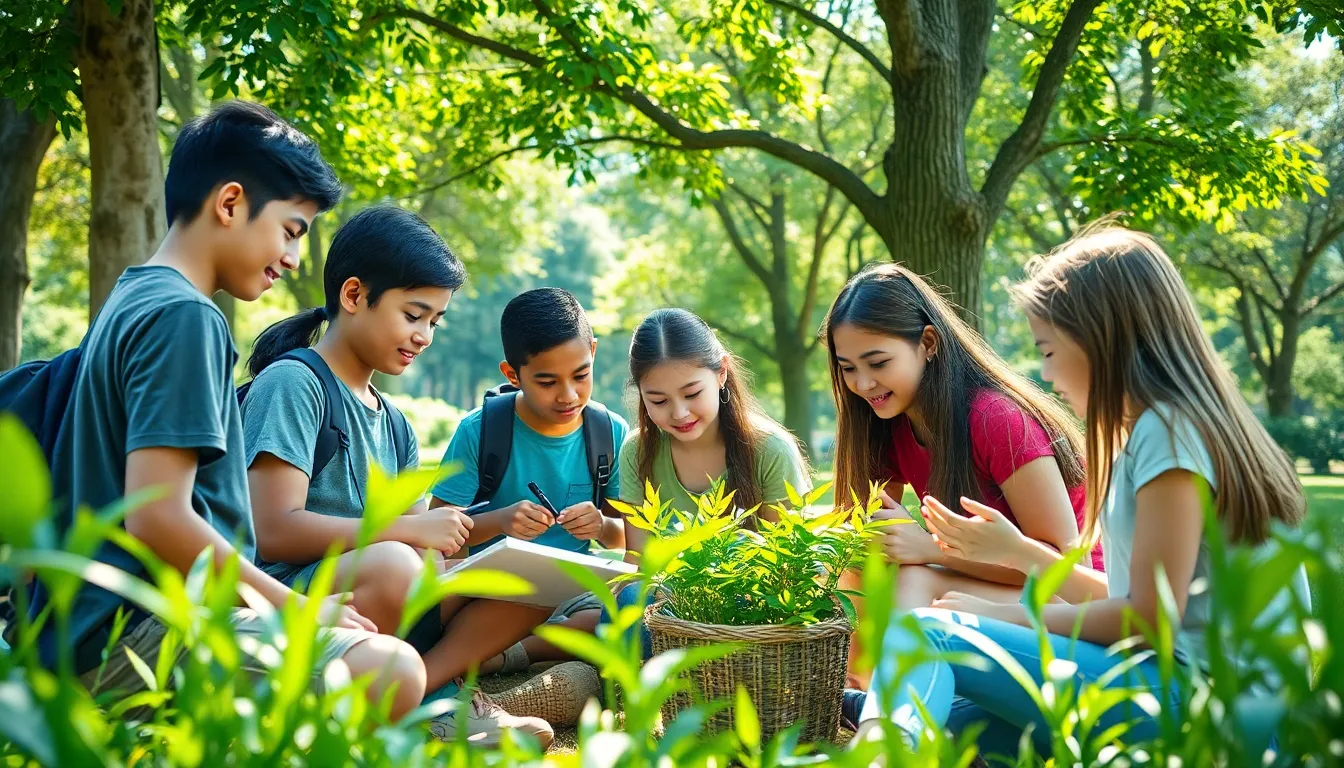Table of Contents
ToggleImagine a classroom where the walls are made of trees and the ceiling is the sky. Outdoor learning activities transform traditional education into a thrilling adventure. Kids swap their desks for picnic blankets and textbooks for nature guides, discovering the world outside their windows.
Not only do these activities spark curiosity, but they also boost creativity and critical thinking. Who knew that a scavenger hunt could teach teamwork or that building a fort could inspire engineering skills? With outdoor learning, students don’t just learn—they experience, explore, and engage in ways that make knowledge stick like mud on a rainy day.
Overview of Outdoor Learning Activities
Outdoor learning activities offer diverse experiences that expand traditional educational methods. These activities embrace nature, facilitating hands-on learning opportunities that enhance student engagement. Educators often use nature trails, gardens, and parks as settings for lessons, encouraging exploration and interaction with the environment.
Experiential learning approaches encourage students to participate in activities like environmental studies and wildlife observation. Setting up science experiments in outdoor settings fosters curiosity about natural phenomena, creating lasting impressions. Engaging in team-building exercises outdoors also develops collaboration and communication skills among peers.
Outdoor activities can include project-based learning, where students work on real-world challenges. Organizing community service projects allows students to apply their knowledge while benefiting the community. A well-planned outdoor classroom supports subjects such as biology, mathematics, and history through interactive lessons.
Scavenger hunts transform typical learning by making it dynamic and cooperative. Using maps and compasses in navigation tasks introduces essential skills while promoting teamwork. Nature walks deepen environmental awareness, combining physical activity with ecological education.
Sports and games in outdoor settings promote physical health and wellness. Incorporating elements of play with curricula helps sharpen focus and retention. Activities like fort-building stimulate imagination and creativity, allowing students to express themselves freely.
Outdoor learning reinforces the connection between education and the environment. By utilizing these activities, educators contribute to holistic development, making learning both enjoyable and effective. Emphasis on outdoor exploration cultivates a lifelong appreciation for nature and its various ecosystems.
Benefits of Outdoor Learning Activities
Outdoor learning activities provide various advantages that enhance the educational experience. Participants gain hands-on experiences in nature, which fosters deeper understanding and appreciation of the environment.
Cognitive Development
Cognitive development significantly benefits from outdoor learning activities. Engaging in nature-based exploration boosts critical thinking skills as students navigate real-world challenges. Flexibility in learning settings encourages curiosity, allowing learners to ask questions and seek answers. Environmental tasks demand problem-solving, enhancing analytical abilities. Research indicates that outdoor activities improve memory retention. Studies support the notion that a diverse learning environment can strengthen cognitive growth.
Social Skills Enhancement
Social skills enhancement occurs naturally through outdoor learning activities. Team-oriented tasks promote collaboration, as students work together to achieve common goals. Communication improves when peers discuss strategies and share ideas. Building connections with others fosters empathy and understanding, crucial for personal development. Observational learning plays a vital role in skill development during group activities, where individuals model positive behaviors. Participation in outdoor settings often leads to improved conflict resolution skills. Engaging in shared experiences solidifies friendships and enhances peer relationships.
Popular Types of Outdoor Learning Activities
Outdoor learning activities encompass a variety of engaging experiences that promote skill development and environmental awareness. Students participate in hands-on learning opportunities that foster curiosity and exploration.
Nature Exploration
Nature exploration encompasses various activities that allow students to connect with their environment. Observing wildlife and identifying local flora encourages curiosity and observational skills. Engaging in hands-on experiences helps students understand ecosystems and biodiversity. Guided hikes along nature trails provide an immersive setting for learning about habitats and ecological interactions. Students can participate in activities such as bug hunts and plant identification, enhancing their appreciation for the natural world.
Team-Building Games
Team-building games focus on collaboration and interpersonal skill development among participants. Activities such as trust falls, obstacle courses, and team challenges promote communication and problem-solving. These exercises encourage students to work together and build a sense of community. Engaging in fun challenges fosters essential social skills, including leadership and empathy. Outdoor settings offer an ideal backdrop for these activities, making teamwork more dynamic and enjoyable. Team-building games create lasting memories while enhancing students’ overall learning experiences.
Implementing Outdoor Learning Activities
Successful implementation of outdoor learning activities relies on thoughtful planning and preparation. Coordinating resources aligns with desired outcomes, while selecting appropriate locations enriches the experience. Engaging stakeholders, including teachers, parents, and local organizations enhances support. Setting clear objectives provides measurable goals for educators. Scheduling activities around seasonal changes also maximizes engagement.
Planning and Preparation
Developing a comprehensive plan starts by identifying specific learning objectives. Teachers research local parks or nature reserves that fit these goals. Involving students in the planning process encourages ownership and excitement. Gathering necessary materials ensures readiness on the day of the activity. Preparing contingency plans accounts for potential weather changes or other unforeseen circumstances.
Safety Considerations
Prioritizing safety during outdoor activities forms the foundation of successful learning. Conducting risk assessments helps identify potential hazards in outdoor settings. Establishing guidelines for behavior reduces risks associated with group activities. Informing students about the environment ensures they respect wildlife and natural resources. Keeping first aid kits readily accessible offers peace of mind for educators and students alike.
Conclusion
Embracing outdoor learning activities offers students a unique opportunity to connect with nature while enhancing their educational experiences. These activities not only cultivate curiosity and creativity but also promote essential life skills such as teamwork and problem-solving. By stepping outside traditional classroom boundaries, educators can create dynamic learning environments that inspire exploration and foster a deep appreciation for the natural world.
As schools increasingly recognize the value of outdoor learning, the benefits extend beyond academic achievement. Students develop stronger social bonds and a sense of community, laying the foundation for lifelong friendships. Outdoor learning activities are more than just fun; they are an investment in holistic development that nurtures well-rounded individuals ready to face real-world challenges.








